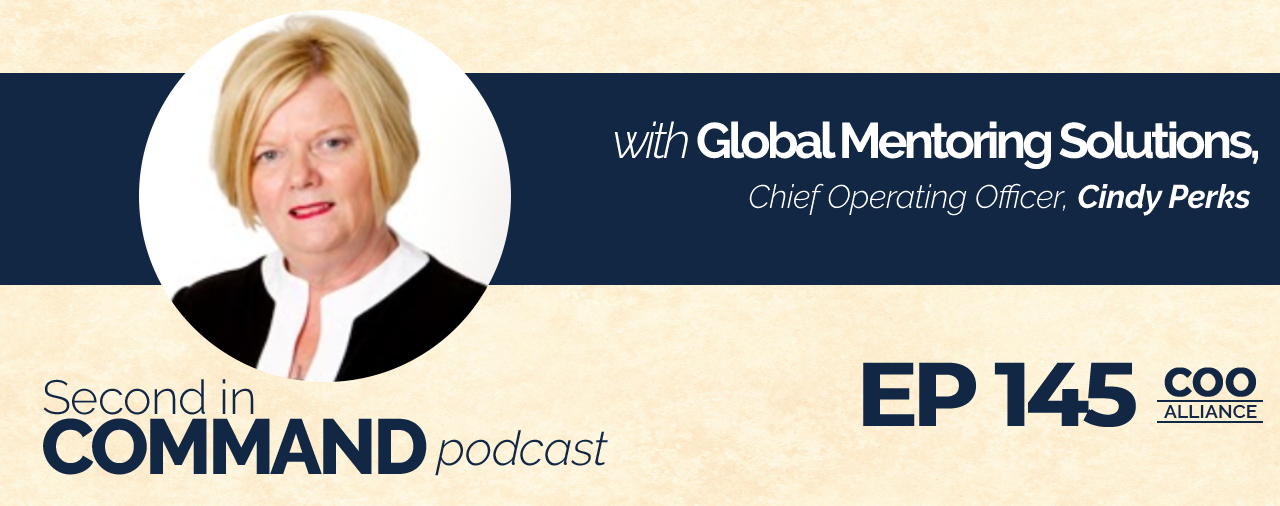Our guest today is Cindy Perks, the COO for Global Mentoring Solutions.
Cindy brings over 30 years of operations management experience and oversees the hiring, training and support structure strategy at GMS. Global Mentoring Solutions offers outsourced help desk support to tech teams of various companies across the globe. Their mission is to boost the value of customer support to ensure continued success in business.
Cindy has an extensive background in the eLearning community and is working to transition Global Mentoring Solutions into an industry leader in the outsourced help desk arena for managed service providers. Cindy Perks tireless efforts as the COO has taken Global Mentoring Solutions from 30 employees to over 130 in just 5 years!
In This Conversation We Discuss:
- The effectiveness of outsourcing: Deciding what to outsource versus what is done inhouse
- How to wow people in the first 30 seconds of a support call
- Identifying patterns from call centers and reporting for amendments to the process
- What systems or mindsets Cindy has in place to stay on the same wavelength with the CEO of Global Mentoring Solutions
Resources:
Connect with Cindy Perks: LinkedIn
Global Mentoring Solutions – https://www.globalmentoring.com
Connect with Cameron: Website | LinkedIn
Get Cameron’s latest book: The Second in Command – Unleash the Power of Your COO
Subscribe to our YouTube channel – Second in Command Podcast on YouTube
The post Ep. 145 – Global Mentoring Solutions COO, Cindy Perks appeared first on COO Alliance.
—
Before we jump into this episode, you need to know about two important ways that we can help you and your company grow. Number one, check out the COO Alliance. It is for COOs, Presidents, VP Ops or whoever is your company’s second in command to the CEO. The COO Alliance is the world’s leading community for the second in command and it gives COOs the tools and connections to grow themselves and the company. Head over to COOAlliance.com to learn more about our members, the results, the program and our 10X guarantee. If you qualify for membership, you can set up a complimentary call with our team to discuss if it’s right for you. I will tell you about number two in a bit but first, let’s start this episode.
—
Our guest is Cindy Perks, the COO of Global Mentoring Solutions. Cindy brings over 30 years of operations management experience and oversees the hiring, training and support structure strategy at GMS. Global Mentoring Solutions offers outsourced help desk support to tech teams of various companies across the globe. Their mission is to boost the value of customer support to ensure continued business success has an extensive background in the eLearning community and is working to transition Global Mentoring Solutions into an industry leader in the outsourced help desk arena for managed services providers. Cindy Perks’ tireless efforts as the COO have taken Global Mentoring Solutions from 30 employees to over 130 in just 5 years. Cindy, welcome to the show.
Thank you very much, Cameron. It’s great to be here.
Thank you. Tell us a little bit about what Global Mentoring Solutions does. Who are your types of clients? What kind of outsourcing do you do for them?
Global Mentoring is dedicated exclusively to technical support on a wide range of topics that have to do with IT desktop applications. We’ve got three lines of business. One is residential through telecommunications, partnering with telecommunication companies. The other is the help desk and NOC services. We do the monitoring for a NOC, Network Operating Center and take action on any alerts that come by. I’ll base this on the premise that 95% of the technological challenges can be overcome remotely, leaving a very small percentage where you have to put your feet on the street and send someone to an actual site. That’s our niche, connecting to the computer, helping the end user and getting it resolved.
Would you be considered first-level tech support, second-level or even higher than that?
We cover the three in the common realm. It’s tier 1, tier 2 and tier 3. We go from levels 1, 2 and 3. It’s our customers that would say in the telco industry, “We want levels 1 to 2 support.” Whereas in the MSP or Managed Service Provider world, they are more apt to want levels 2 to 3.
What kind of telcos are you working with? Are you with Rogers or Bell Canada? Is that whom you’re doing work for?
Yes. We provide support for Bell Canada.
How did these big companies outsource this stuff? I was coaching a company and I got frustrated with them going, “God, you are 250 employees and you still try to do everything in the house.” I held up an iPhone and said, “Who makes this iPhone?” They said, “Apple.” I said, “No. Apple doesn’t make iPhones. They outsource that. Why are you trying to do everything?” A company like Bell Canada which is massive and has been around forever, why are they outsourcing? How do they decide what to outsource versus keeping it in-house?
The best way to answer that question is Bell Canada for example, at Global Mentoring, we’re always in desktop support and desk-side support but we always use the chat. We have our proprietary chat program. Due to our career histories and experience, we’re very connected to the eLearning community. When eLearning was getting off and going into online learning and video learning and replacing the very traditional classroom, we provided the support.
A student taking an MCSE through Microsoft would come to us when they got stuck with something or when they didn’t understand something. We were providing that application support but at a very high end. Our mentors, as we call them, are not agents. They knew the products better than the students because they were certified and had already gone through that. We saw this need in the eLearning community. The flaw with the model was that eLearning and training for end users in the corporate world is the first thing to get cut when you want to cut expenses.
Training for end users in the corporate world is really the first thing to get cut when you wanna cut expenses.
In this country and North America, in general, we train our executives far better than we train our receptionists and the people that do the work. There wasn’t a big market there. Once upon a time, there was a little outfit in Eastern Canada called Alliant. They were part of Maritime Tel &Tel. Alliant had a big strike. Managers were on the phones taking phone calls from the end users and they discovered that they couldn’t fix everything in applications and how to do something. How do I get my pictures downloaded to my computer? Those kinds of things were coming into the telecommunication and they had no avenue to provide support. They saw a need.
Six months later after the strike was over, they approached us and said, “We hear what you guys do. Let’s talk about providing residential support for users.” That’s how we got into it. It was strictly chatting. We didn’t want to get into phones, especially with telecommunication folks. At the end of 2009, we said, “Let’s add the phones. We can do it better than anybody else can do.”
Did you start with live chat?
Yes, we started with live chat years ago.
I remember using LivePerson. It was the software we used in 1999 and 2000 so you were already big into that whole space. You picked up the phone side just because you figured you could add that in.
No offense, but also do it better than anybody that was currently in that space.
The call center industry has a reputation for being minimum wage jobs or lower paid jobs. I would get the sense that you’re probably not at that lower paid level when you’re providing some of the tech support you’re paying.
No. We’re paying for talent and certification for us. We cut our teeth in the education industry so we truly believe that certifications in IT are the way to go. We hire at a higher level and pay under the dedicated technical support that you would hire for your organization. If you wanted to hire the IT guy, you would be paying the IT guy if they had the number of certifications that we require. You can hire that IT guy a bit above where our folks are. Our folks are ahead of the contract.

Global Mentoring Solutions: Because we cut our teeth in the education industry, we truly believe that certifications in IT is the way to go.
I’m sure you’ve come across Lynda.com. I was at the TED conference a couple of years ago and I was sitting beside this woman. I was raving about Lynda.com, an amazing platform for technical learning. I said, “What do you do?” She goes, “I’m Lynda.” I’m like, “No way.” I was sitting beside Lynda from Lynda.com. That is so random. It blew my mind. In scaling the company from where you’ve been, all of your people in Canada, are they remote or global?
All of our mentors are in North America. That’s a prerequisite. We closed the last of our brick-and-mortar operations in 2007 and we’ve been work-from-home since then. With that concept, we always jokingly say working from home does not mean you can work from anywhere. It means we can facilitate the work-from-home model and we’ve been very successful in that regard. All agents are North American-based. We have a large need for bilingual, French and English.
We do a lot of recruiting in New Brunswick, Quebec and outside the Ottawa region for our bilingual requirement. The rest is coast to coast and in the United States. Most of our MSP partners are American. To service the American marketplace, we sometimes require only American agents and mentors can touch certain companies and requirements in the US. We do have a small band of US folks as well.
Why is that? Is it because the client likes the accent or they can chat quickly like, “I’m from Chicago, too. I’m from Kansas,” or they can connect a little bit more?
There’s a little bit of that. More so, it’s the security side of things. Anyone that has any government, agencies, state, municipal or federal has a requirement for certain aspects to only be touched by US employees. It’s more security. The accent and other things do come into play. Although everybody’s getting very sophisticated so we can’t say, “Your accent is putting us out.”
It’s funny. I was speaking with an agent from a company. She had an East Indian accent. I’ve been to India four times. I love India. I was like, “I know this is a weird question but are you from India?” She goes, “We’re not allowed to say.” I’m like, “No, I don’t care. I love India. Where are you from?” She goes, “No, I can’t say that.” I could tell that she was because she was laughing on the other end of the line. I’ve gotten over it. As long as the support is good, I don’t care where you are.
We believe that you have about 30 seconds to gain the trust of the end user who’s having trouble. They’re calling. They’re frustrated. Nobody calls the help desk when they don’t need help. We place a lot of emphasis on that first 30 seconds, making sure that that’s good.
That was something at 1-800-GOT-JUNK? that we obsessed over. We kept trying to go and learn from WestJet because they were wowing us on the phone and we kept trying to learn from their call center groups. How do you wow people in the first 30 minutes? Can you give us some of the secrets or systems that you use to do that? Is it just more of a mindset that you try to set with the mentors?
It’s a mindset. One of the things is we don’t play around with the IVR, which means that we don’t give you a greeting that’s phenomenally well-recorded and then you wait and we connect. You are connected with a technician right away. That’s important that you know that this technician can help you. You’re not going to be passed around or put on hold. You’re speaking with an expert at that. We try to avoid the cliches. We try to avoid saying, “This call may be recorded for quality control.” We say, “This call is recorded for quality control,” because we use it for training as well.
That’s the stuff that drives us all crazy too. We’re dealing with one where my girlfriend was in Columbia, had her phone stolen and had to get it replaced. The agent knew that and I had to patch in my girlfriend. She starts with the script again like, “How’s your day going?” I was like, “Are you kidding me? We’re three days in. You know my phone is stolen. My day’s shitty.” “How is your day going?” “Can we please get past the script?”
Question for you on the call center side again or with the mentoring. When they start identifying patterns, it’s the question or problem, do you report that back to the company to say, “If you fix this, we’d get 20% fewer calls?” Do you help them with that at all?
We do.
It has got to be hard because you almost put yourself out of the job if you do that well.
Here’s the thing about that. You asked me about how we set our sights on getting a company to outsource to us. One of the key things is when you’re hiring the IT guys, you’re hiring a large plethora of brain cells that have technology inside of them. You’re paying them to create revenue opportunities for you at a higher level. The reality is that the people who need help are at the lower level. You’ve got this IT guy that can work up a new topography on a network better than anybody and you got them answering, “My printer won’t print.” We try to take away the non-revenue bits and identify those and then they can add value to their customer by going in and saying, “That printer has been down four times this month. It’s time to replace it.” Your productivity is being affected.

Global Mentoring Solutions: When you’re hiring the IT guys, you’re hiring a really large plethora of brain cells that have technology inside of them. You are paying them to create revenue opportunities for you at a higher level when reality is that the people that need the help are at the lower level.
That probably does build loyalty with the company as well. You’re becoming more of a partner with them than you are a call center. You’ve got only 150 employees. What’s your turnover or attrition with your employees? Is it high? Is it reasonable? Do you benchmark that into the industry?
Our attrition has been extraordinarily good. I looked at a report and we’ve had phenomenal growth in the last few years. We have doubled our number of mentors. We call our agents from time to time and we insist on them continuing to learn. With lifelong learning, we cut our teeth in the eLearning industry but we truly do believe in it. We drank the Kool-Aid a long time ago and try to keep our employees current with their technologies and their need to learn and keep that. If you don’t keep your technology current, you become stale very quickly.
If you don’t keep your technology current, you will become stale very quickly.
Do you outsource your recruiting? Do you do that in-house or do you do a bit of both?
We do it in-house. We have recruitment in a separate category. We call that talent acquisition. We’ve been training a gal that will do only recruitment. That’s her expertise and that’s what she’ll be doing for us.
It’s such a different skillset than other areas of HR. It’s like saying, “Just because I’m a quarterback for a football team doesn’t mean I’d be good as a kicker.” You wouldn’t be at all. Yes, you both play for the team but you’re in different roles. Kept throwing the ball and catching the ball. Was there ever an issue that you were at home-based tech support prior to COVID? I’m guessing post-COVID, they’re like, “It doesn’t matter.” Was there ever anything before where they’re like, “Weird, you’re not in an office?” Did that ever go against you?
A couple of times, we had to address the elephant in the room. There are some of the things that come out of marketing and spinning. Think about the geographical disbursement of our workforce. If there’s a hurricane in New Brunswick, then our folks in Alberta can pick up the slack. We’re geographically situated and we can cover any of those regional challenges that come up.
You did find ways to spin it back then.
We did. We go over the top on security and so on. We record everything that happens on the desktop of that mentor when they’re working for GMS like their keyboards and voices. We watch their activity. Big brother’s watching. We watch their Googling. All of those things are watched. There’s very little that goes on that we don’t know about.
I would guess that that issue has been erased. I was speaking with a second-in-command for Wikipedia. They’ve got 450 employees. She said she told all 450 employees not to come back to the physical office space until July 1st, 2020. This has got to be game-changing for you on the sales and marketing side.
It was huge. One of the things that we noticed though is because we were already at home, we did not have to orientate our staff to be at home and work from home but we had an influx of people that were dispersed to their home office from a big office. We’re supporting 1 network and 1 server but now we’re supporting 300 small and independent little areas while they get it all together. We were extremely busy in April and May 2020.
With our staff, we’ve had to become very creative in trying to give them what they used to have. They used to enjoy their eight-hour shift and then they could go to the gym and out for dinner. They had a way more social life. In 2020, they can’t. They’re at home. Not only that but they were working from home by themselves. The kids were not in school. Some things came up that made our job at the top a little more difficult.
You did have to adapt that as well. You were already work-from-home but with different parameters. That would throw everybody into a bit of a tailspin. They used to work from their daughter’s bedroom and then their daughter’s home. It’s like, “Shoot, what am I doing?” Talk to me about the onboarding of employees. Recruiting and interviewing them remotely is easy but the onboarding of remote employees, what have you learned over the years in doing that?
We’ve learned that although people say that they’re well set up, they’re not. We find it interesting when we’re interviewing that the bigger the gamer, the more technology that they have, the more security they have themselves and those kinds of things. That’s pretty good. We’ve used Zoom since Zoom was beta. We’ve had it. We love it. Our CEO is quite innovative and martini shaken. He wants new toys all the time but we always go back to Zoom because it’s very reliable, meets our needs and so on.
We Zoom with everybody. We Zoom with our new employees. When they’re in training with the things that are digitized, we meet the team and so on but we do try to interject with more meetings. Wayne Goldstein is our CEO. Both Wayne and myself will attend the MSP Team meeting and we’ll meet with the mentors and listen to their challenges. You got to have big ears because you’re not overhearing anything. You have to be conscious about hearing.
You got to be proactive about trying to hear because you’re right. You don’t overhear it all.
That’s what we try to do.
I hadn’t thought of that yet. I’m making a note of that. I started using Zoom right around the same time because I was always frustrated with Skype and then when Microsoft bought Skype, I was in the exit stage. Microsoft has come back full circle. They’re doing a good job. They seem to have got Microsoft Teams working. I’m not using it but they got a chance again. How about your development as a leader over the years? Where do you think you’ve grown the most as a second-in-command?
In the last few years, I’ve grown the most. Prior to that, there’s so much to learn. Sometimes learning doesn’t necessarily mean growing. I look back and think what I can provide my team is wisdom and expertise, as long as I don’t overdo it. Back in the day, we used to do it this way. You need to be very careful about that because that gets stale very fast.

Global Mentoring Solutions: Sometimes learning doesn’t necessarily mean growing.
With the people coming up, I always like to think that I’ve allowed for a succession strategy. People coming up in the ranks. There are a couple that could be very good second-in-command one day. My job is to expand their vision and look all around. Operations people tend to be so very focused on one area. I like to encourage the ops folks to walk 1 mile in the sales shoes and see it from their perspective. Most of us see it from the customer’s perspective.
Starbucks does an interesting job with that at the leadership team level. They’ve got about 45 people at their C-Suite and Executive VP levels. They make people change business areas every three years. If you’re running EVP of something, three years later, you’re running an EVP of a different area because they’re always trying to cross-train everyone as one but also to be more empathetic of the whole business as well.
One of the few reality series that I enjoyed and learned a lot from was the show where the boss went undercover. Undercover Boss. I found that extremely fascinating because my CEO does that a lot. When COVID first hit, we were getting very busy and not able to know if the retention of these customers are solid. What’s going to happen? First of all, we lost all hospitality. Business from a revenue perspective is going down but business from an incoming call and chat perspective is increasing dramatically.
How do you make those two things fit? Being a private boutique, our CEO said, “It’s time for us to look.” We started focusing on a book by Gino Wickman, Traction. I’m looking at the entrepreneurial operating system. Right people, right seat, right time. We clung to that and looked at all of our areas to make sure. We looked at our quality assurance team and said, “Let’s use this time to look at what we talked about a little earlier. Look at those quality incidents that are coming in. How can we proactively minimize the quality incidents?”
Right people, right seat, right time.
Our knowledge base was one area. We looked at ways to improve that and go back to our partners and said, “You need to beef up your documentation in this area.” That would alleviate quality frustration at the end-user level. We looked at our escalation procedure and have an approval process. We’ve got a group of people that sit there all day long and approve escalations. What about we stop doing escalations and repurpose those folks?
We had a tier of managerial folk that was able to go back to the front line in different capacities but helps that whole call thing. We did a pivot, looked at each of the jobs at all levels and said, “Do we have the right folks or not?” Surprisingly, we did. Some that we repurposed at that point flourished. I don’t see us ever going back to the old QA at all. I like what we were able to accomplish.
There’s something I always felt off with me on QA as well, which is if we were doing it properly, we wouldn’t need QA. Why don’t we do it properly and then eliminate the waste? Do you see AI starting to change your industry in terms of the support being able to provide by having computers provide the first 80% of the support? Most of it sucks.
I’m chuckling because one of the things I said in 2021 planning for our new fiscal year was, “The A in AI is Artificial.” We ought to start looking at our areas and how we mine our knowledge base. The robotics goes away and the information that we’re giving to the AI product has some foundation in reality. It’s real data. That’s the challenge, getting that data into an acceptable format.
We’re still a few years away from it. The adoption is going to be very fast. I rode in the very first Google experimental car years ago at the main TED conference. The guy from Google was doing the TED Talk and then he said, “If you want to go drive in it, it’s outside.” One thousand eight hundred of us like Bill Gates stood up and went running out the door. I’m like, “What is going on?” I rode in it. I was sitting beside Matt Groening, the Founder of The Simpsons was sitting beside me. We’re twelve-year-olds. We’re like, “This is amazing.” This won’t even be around in the next several years.
Years ago, my Tesla drove me from Seattle to Vancouver and drove 90% of the miles on its own. The adoption is coming and it’s faster but it’s not there yet. How about you and Wayne, the CEO, how do you stay on the same page together? What do you do in terms of systems, mindsets or date nights? What do you do to stay on the same page with each other?
We have our fireside chats. One of the things that I have never underestimated was in my thought process, there are two COOs. There are the ones that have their operational agendas and processes. They’re respectful of ITIL, ITSM and all of those other wonderful processes and procedural components. There’s a COO like myself. My role is to deploy, implement and assist the CEO’s vision.
He’s truly an entrepreneur and has always been a great innovator. We joke about the fact that he has always been right on the mark. I give him certainly some guidance and point out some risks but together, I hear the vision and then we discuss how we can deploy, implement it and take it to the masses. It’s through that collaborative method that served us very well as a team in the last years, for sure.
That sounds like a huge amount of trust between each of you to stay in your lanes too. As long as you know what his vision is and then he knows what your plan is, you’re both good. That handoff is fluid.
It is. It happens naturally.
Let’s go back to the 22-year-old Cindy. She’s graduating college and she needs some advice from her future self. What would you tell the 22-year-old that now you know to be true but you wish you’d known back then?
Don’t spend the first fifteen years of your career following the rules. Spend the first fifteen years of your career understanding why the rules are there and finding if there is a better way of doing that. Become more efficient and proactively empowered. Right out of the gate at 22, that would’ve changed me for the better all the way along.
That was one of the core values of a company out of Vancouver called Nurse Next Door. One of their core values was, “Find a Better Way.” They wanted people to break the system and ask questions.
We’ll make it as possible. It can be rewritten.
Cindy Perks, the COO of Global Mentoring Solutions, thank you very much for sharing with us on the show.
Thank you very much, Cameron.
Important Links
About Cindy Perks
 COO at Global Mentoring Solutions, 24/7 Outsourced Help Desk & NOC
COO at Global Mentoring Solutions, 24/7 Outsourced Help Desk & NOC





